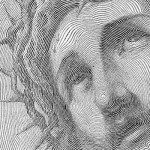by Fr. Patrick Henry Reardon
 Edgar Allen Poe, in his penetrating review of Bleak House, remarked that no reader can comprehend the real wealth of that work in a single reading. Numerous shades of nuance, Poe explained, and dozens of subtle connections were woven so deeply into the fabric of Bleak House that their presence was not even suspected on a first reading.
Edgar Allen Poe, in his penetrating review of Bleak House, remarked that no reader can comprehend the real wealth of that work in a single reading. Numerous shades of nuance, Poe explained, and dozens of subtle connections were woven so deeply into the fabric of Bleak House that their presence was not even suspected on a first reading.
On a second reading, however, the now enlightened reader knows what to look for; he will perceive treasures that eluded his attention the first time through. Innumerable lines will shine now with a new luster. Thus, concluded Poe, fully to grasp the meaning of Bleak House for the first time, the reader is obliged to go through it a second time.
One suspects here the presence of a permanent literary principle, namely, that any story truly worth reading is worth reading two or more times. Even little children seem to know this. I have never met a child content with a single reading of a good story.
Another test case for Poe’s principle, let me suggest, is the Gospel according to St. Matthew.
I have long believed that the Missionary Mandate received by the apostles in the closing verses of that Gospel is the best key to understanding it as a whole. That is to say, after reading Matthew all the way to its memorable ending, it is most instructive to take that ending as an interpretive guide and go back through the Gospel again, considering everything else in the light of it.
An easy way to do this, I suggest, is to reflect on Matthew’s Missionary Mandate with respect to structure, theme, and imagery.
First, in regard to structure, we observe that Matthew employs a method called inclusio, by which he begins and ends his work with a common element. Thus, the Jesus who is first declared in Matthew to be
“God with us” (1:23)
declares in the Gospel’s last verse,
“Behold, I am with you always, even to the end of the world” (28:20).
Similarly, Matthew treats of baptism at both the beginning and the end of Jesus’ ministry. Following an inherited apostolic format that describes that ministry as
“beginning from the baptism of John to the day when [the Lord Jesus] was taken up from us” (Acts 1:22),
Matthew portrays the revelation of the Father, the Son, and the Holy Spirit when Jesus is baptized by John (Matt. 3:16–17). Then, at the end of the Gospel, Jesus himself speaks of baptism
“in the name of the Father, the Son, and the Holy Spirit” (28:19).
Thus, the Trinitarian structure of baptism provides Matthew with the two end posts of his narrative frame.
Second, in regard to theme, Matthew finishes his work with the conversion of the world:
“Go therefore and make disciples of all the nations.”
This call to the nations (ethne) summarizes a motif found often in Matthew (cf. 12:18,21; 21:43; 24:14; 25:32). Even at Jesus’ birth, the Magi, personifying those nations, came to adore him (proskyneo—2:2,8,11). At the end, while his disciples are on the mountain adoring him (proskyneo—28:17), Jesus sends them out to make disciples of those very nations.
Third, with respect to imagery, we observe that the Missionary Mandate is given on “the mountain which Jesus had appointed for them” (28:16). In Matthew, the mountain is preeminently the place of authoritative revelation (15:29–30; 17:1–5; 24:3). Indeed, Jesus’ first major sermon in Matthew is delivered on a mountain (5:1; 8:1).
On an even earlier mountain, Jesus is portrayed as rejecting Satan’s offer to give him
“all the kingdoms of the world and their glory” (4:8).
Those same kingdoms appear at last on Matthew’s final mountain, where the Lord sends out his apostles with the mandate to
“make disciples of all the nations” (28:19).
On Matthew’s first mountain, Satan offered Jesus universal power. On his last mountain, Jesus commissions the apostles to a universal evangelism founded in his own authority as the Son of Man prophesied by Daniel:
“All authority has been given to me in heaven and on earth. Go therefore and make disciples of all the nations.”
Furthermore, this mountain, from which the nations (ethne) are to be evangelized, is found in Galilee (28:16; cf. 28:7), the very region that Matthew earlier identified as “Galilee of the nations” (ton ethnon—4:15). It was in that “Galilee of the nations” that Jesus began his own ministry (4:12), an early promise of the apostolic commission to extend discipleship to all the world.
Patrick Henry Reardon is pastor of All Saints Antiochian Orthodox Church in Chicago, Illinois. He is the author of Christ in the Psalms, Christ in His Saints, and The Trial of Job (all from Conciliar Press). He is a senior editor of Touchstone.
